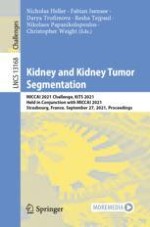2022 | Book
Kidney and Kidney Tumor Segmentation
MICCAI 2021 Challenge, KiTS 2021, Held in Conjunction with MICCAI 2021, Strasbourg, France, September 27, 2021, Proceedings
Editors: Nicholas Heller, Fabian Isensee, Darya Trofimova, Resha Tejpaul, Nikolaos Papanikolopoulos, Christopher Weight
Publisher: Springer International Publishing
Book Series : Lecture Notes in Computer Science
